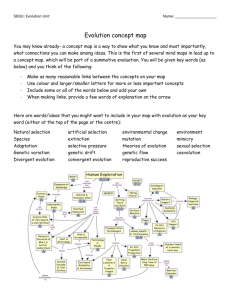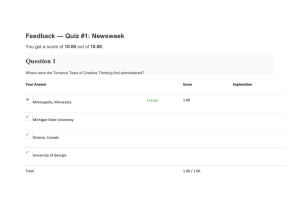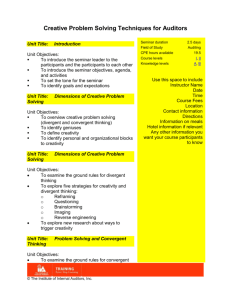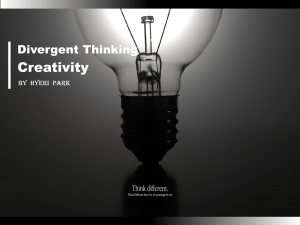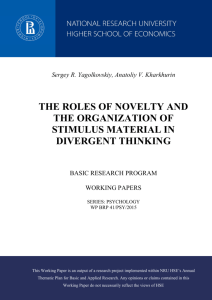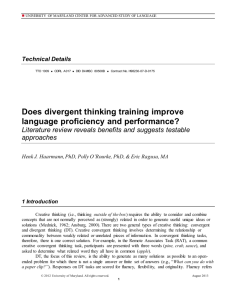Team Creativity - Georgia Institute of Technology
advertisement
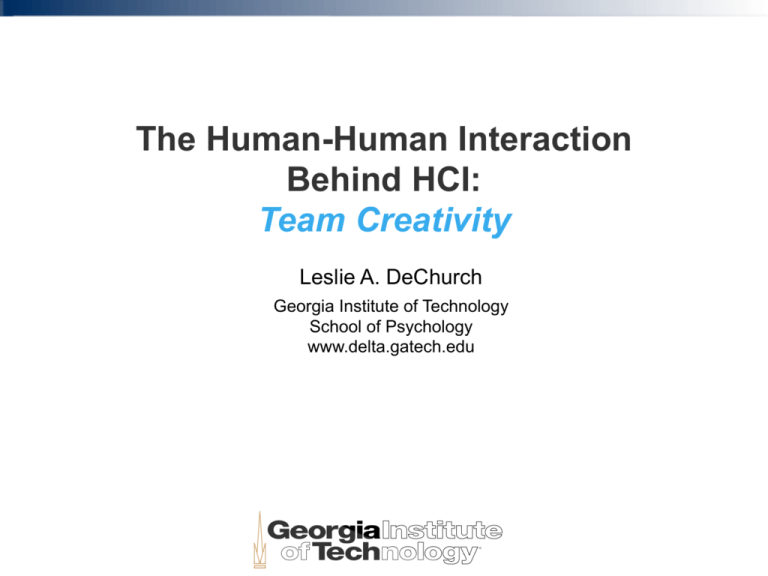
The Human-Human Interaction Behind HCI: Team Creativity Leslie A. DeChurch Georgia Institute of Technology School of Psychology www.delta.gatech.edu Creativity The production of novel (and useful) ideas; ideation Innovation The realization of new products and/ or services as a result of new ideas; also known as idea implementation Four General Conceptual Domains into which New Ideas Can Be Classified Dimension 2: Structural Connectedness – fit with current products & services Dimension 1: Creativity – novel or traditional Finke, 1995 Team Brainstorming The evidence: Teams aren't good at brainstorming. Don’t we often use them for this very purpose! Exercise: Food for Thought Exercise: Food for Thought Team Brainstorming Task Goal is to come up with as many category labels as possible Sit with your project teams; Don’t start until instructed to do so All ideas need to be recorded on the handout Ideate for 10 minutes Food-for-Thought: Results Team Members Fluency Flexibility Originality Quantifying Creativity Fluency Flexibility Originality Counterintuitive: Quantity ultimately leads to originality Flexibility is key How do we promote flexible thinking in teams? Relationship between Fluency & Flexibility 50 45 40 35 Flexibility 30 25 20 15 10 5 0 0 20 40 60 80 Fluency 100 120 140 160 Teams are not Normally Creative Convergent & Divergent Thinking C: proceeds toward a single answer D: proceeds outward from the problem in many directions Teams excel at convergent thinking (conformity, agreement) ….but they benefit from divergent thinking, followed by convergent thinking Teams Need Process Interventions The solution: Teams must manage the process to “norm” divergent thinking first Case in Point: IDEO Process Interventions to Make Teams Creative Teams must manage the process to “norm” divergent thinking first Case in Point: IDEO Four Horseman of the Creative Apocalypse Social loafing – tendency for people to work less hard in a group as compared to working alone Conformity – desire to be liked and accepted inhibits free expression of ideas Production blocking – members cannot express ideas because others are talking Performance matching – team members converge in their performance levels over time, this can lead to downward norm setting Thompson, 2008 Face-to-Face Teams need to “Act Like Virtual Teams” F2F Teams Gain More Value from Information Exchange when they focus on Divergent Views Mesmer-Magnus, DeChurch et al., 2011 Virtual Teams Gain More Value from Information Exchange when they focus on Convergent Views Evidence-Based Interventions Process Interventions – How you interact while brainstorming Organizational Interventions – How you control how you interact while brainstorming Structural Interventions– Creative inputs; the people, their social environment, the team’s environment • Set high quantity goals • Explicit set of rules • Paulus’s new rules • Positive mood • Increase individual accountability • Analogical reasoning • Trained facilitators • Brainwriting • Brief breaks • Nominal group technique • Delphi technique • Stepladder technique • Diversify the team • Fluid membership • Organizational networking • Traverse industries • Build a creative space and environment Thompson, 2008 Rules for Brainstorming 1. Expressiveness: Express any idea that comes to mind, no matter how weird, strange, or fanciful. Do not be constrained or timid. 2. Nonevaluation: Do not criticize ideas. Do not evaluate any of the ideas during the generation phase. 3. Quantity: Generate as many ideas as possible. Strive for quantity! Quantity increases the probability of finding novelty. 4. Building: Modify and extend the ideas suggested by others whenever possible. Osborn, 1957 Paulus’s New Rules 1. Stay focused on the task 2. Do not tell stories or explain ideas 3. When no one is suggesting ideas, restate the problem and encourage each other to generate ideas 4. Encourage those who are not talking to make a contribution Use of these rules can increase idea generation by 40% Oxley, Dzindolet, & Paulus, 1996 For replicable creativity in teams… structure the process Flawed Process Vigilant Process Thompson, 2008 Failure Outcome Successful Outcome Predictable Failure “Lucky” Nonreplicable success “Unlucky” Predictable success Best condition for replicable success

